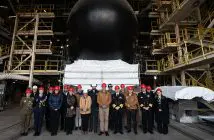
The University of Western Australia’s ‘TeraNet,’ a network of optical ground stations specialising in high-speed space communications, has successfully received laser signals from a German satellite in low Earth orbit. This breakthrough paves the way for a 1,000-fold increase in communication bandwidth between space and Earth.
The ground stations received laser signals from OSIRISv1, a laser communication payload from the Institute of Communications and Navigation of the German Aerospace Center. OSIRISv1 is installed on University of Stuttgart’s Flying Laptop satellite. The signals were detected during flybys of the satellite on July 11, 2024.
“This demonstration is the critical first step in establishing a next-generation space communications network across Western Australia,” said Associate Professor Sascha Schediwy, who leads the TeraNet team at UWA. “The next steps include joining this network to other optical ground stations currently being developed in Australia and across the world.”
The TeraNet ground stations use lasers instead of traditional wireless radio signals to transfer data between satellites in space and users on Earth. Lasers can potentially transfer data at 1000s of gigabits per second because they operate at much higher frequencies than radio, packing much more data into every second. As the number of satellites in space has grown, with each new satellite capable of generating more data, there is now a critical space bottleneck in getting data back to Earth.
UWA says that laser communication is well suited to solving this problem, but the downside is that laser signals can be interrupted by clouds and rain. The TeraNet team is mitigating this downside by establishing a network of three ground stations spread across Western Australia. If it’s cloudy at one ground station site, the satellite can download its data to another site with clear skies.
The TeraNet network comprises a ground station at UWA, a second ground station at the Mingenew Space Precinct 300 kilometres north of Perth, and a mobile ground station fitted onto the back of a customer-built Jeep truck is being built at the European Space Agency’s New Norcia facility.
The TeraNet team received funding from the Australian Government, the Western Australian Government, and UWA in 2023 as part of the Australian Space Agency’s Moon to Mars Demonstrator Mission grant program. The AUD6.3m project supports the construction of the three TeraNet optical ground stations in Western Australia, with the German Aerospace Center providing in-kind access to their laser communications-equipped on-orbit satellites.
Going forward, TeraNet will support multiple international space missions operating between low Earth orbit and the Moon, using proven conventional optical communications standards and more advanced optical technologies, including deep-space communication, ultra-high-speed coherent communications, quantum-secured communications, and optical positioning and timing.





